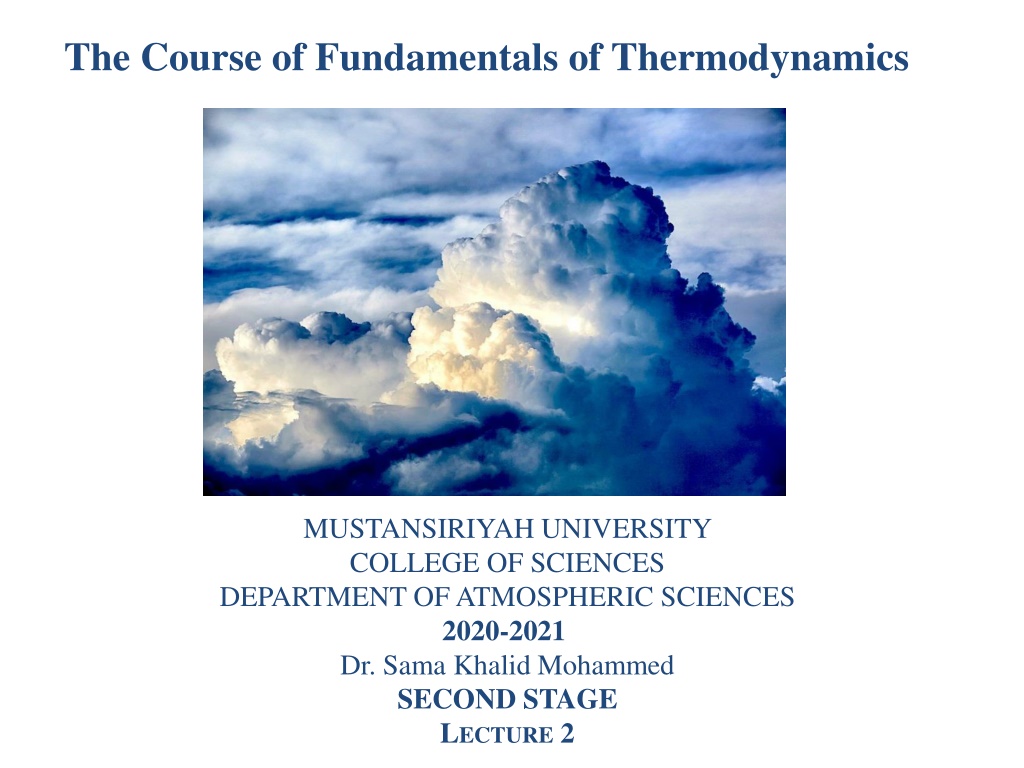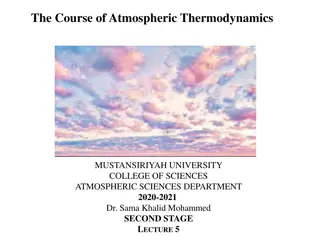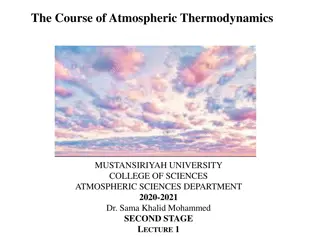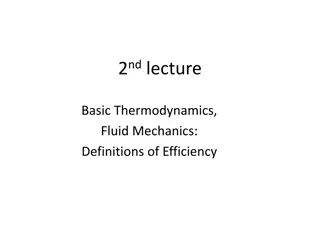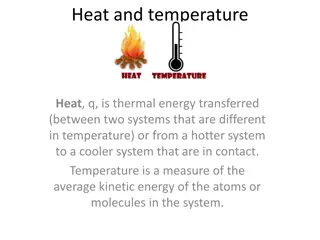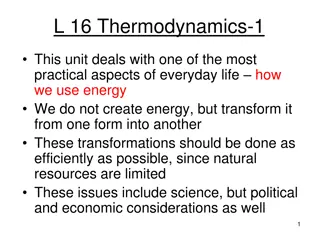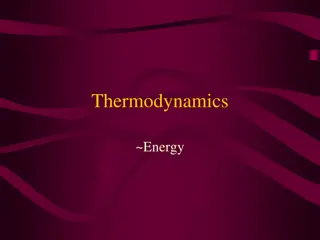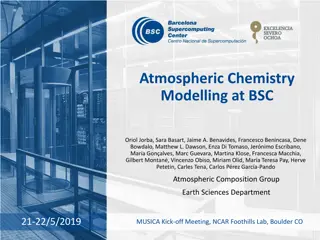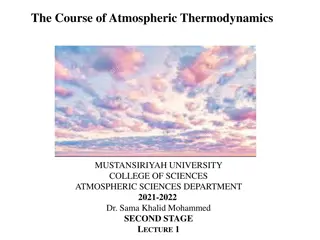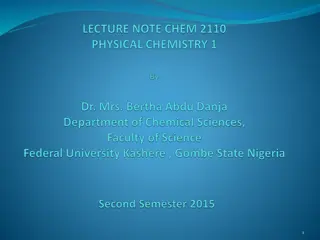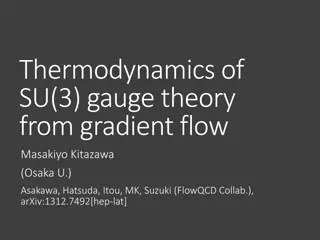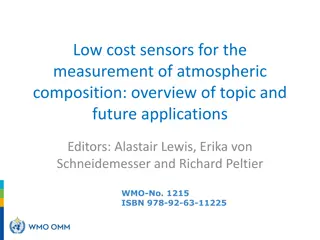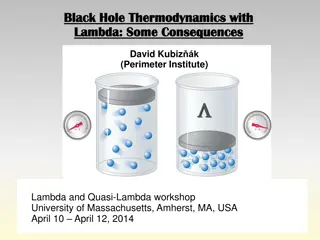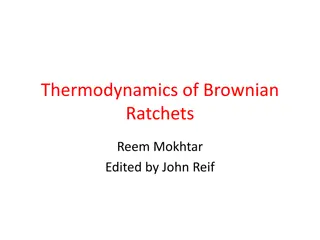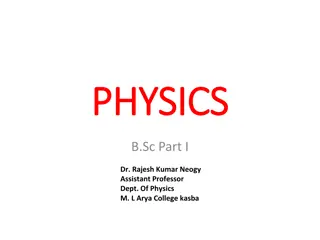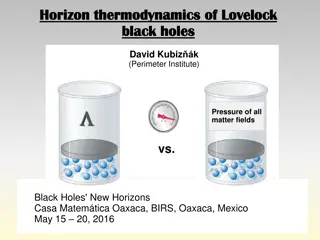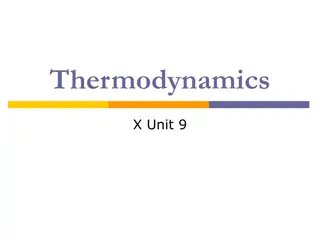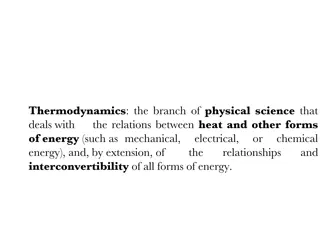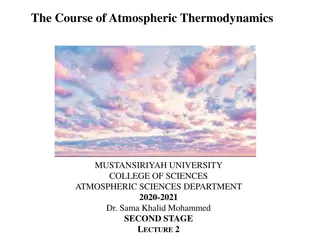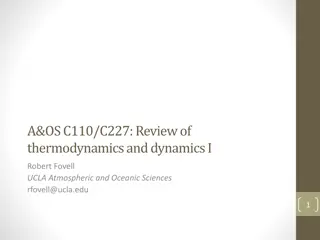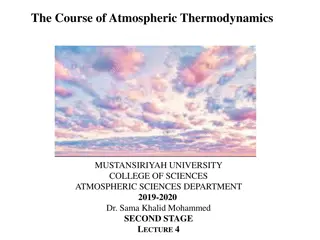The Fundamentals of Thermodynamics in Atmospheric Sciences
Explore the key concepts of thermodynamics in atmospheric sciences as discussed in the second stage lecture, covering topics such as extensive versus intensive variables, reversible and irreversible processes, cyclic processes, and thermodynamic variables. Gain insights into properties of systems, ways to convert extensive properties into intensive properties, and understand the concepts of state and equilibrium in a system. Dive into the depths of thermodynamics with Dr. Sama Khalid Mohammed at Mustansiriyah University.
Download Presentation

Please find below an Image/Link to download the presentation.
The content on the website is provided AS IS for your information and personal use only. It may not be sold, licensed, or shared on other websites without obtaining consent from the author. Download presentation by click this link. If you encounter any issues during the download, it is possible that the publisher has removed the file from their server.
E N D
Presentation Transcript
The Course of Fundamentals of Thermodynamics MUSTANSIRIYAH UNIVERSITY COLLEGE OF SCIENCES DEPARTMENT OF ATMOSPHERIC SCIENCES 2020-2021 Dr. Sama Khalid Mohammed SECOND STAGE LECTURE 2
Welcome Students In The Welcome Students In The New Course New Course And In The And In The Second Lecture Second Lecture
This lecture including the following items Extensive versus Intensive Variables Transformations Reversible and Irreversible Processes. Cyclic Processes Thermodynamic variables
Properties of System Any characteristic of a System is known as its PROPERTY, ex. Pressure (P), Volume (V), Temperature (T), mass (m), etc. In Thermodynamics, two property of a system is considered: Intensive and Extensive. An intensive property is one that does not depend on how much substance is present. Temperature is an example of an intensive property. If two identical masses are at the same temperature and are added together, the temperature remains the same even though the mass is doubled. An extensive property depends on how much substance is present. Internal energy is an example of an extensive property. If the two identical masses are added together there is twice as much internal energy. If you cut a system in half and re-measure its properties, intensive properties remain unchanged, while extensive properties are cut in half.
Properties of System There are two ways to convert an extensive property into an intensive property: Divide by the mass. The result is a property that is normalized by the mass. We add the term specific to indicate that we ve divided by the mass. For example, the specific internal energy u is defined as U/m. Divide by the number of moles. The result is a property that is normalized by the number of moles present. We add the term molar specific to indicate we ve divided by the number of moles. For example, the molar specific internal energy, um, is defined as U/n. In general, extensive properties are denoted using upper-case letters, while intensive properties are denoted using lower-case letters. However, there are exceptions, including ONE NOTABLE EXCEPTION: Temperature is denoted using upper-case T, even though it is an intensive property.
State and Equilibrium Assume a System NOT undergoing any change. Set of macroscopic properties to completely describe the condition of the system is known as its STATE or (State: condition described by observable macroscopic properties (state variable)) as we defined it in Lecture 1. EQUILIBRIUM is a State of Balance
Thermodynamic Equilibrium State It is a state in which the system s properties, so long as the external conditions (surroundings) remain unchanged, do not change in time (no spontaneous changes). For example, a gas enclosed in a container of constant volume is in equilibrium if its pressure is constant throughout and its temperature is equal to that of the surroundings. There are three types of equilibrium: Mechanical equilibrium This means there are no unbalanced forces, so that neither the system, nor any part of the system, undergoes accelerations. This also implies that there is no turbulence within the system. Material equilibrium This means that there is no net transfer of matter from one phase or component of the system to another. The concentrations of chemical species and their phases are constant with time ( i.e. phase and chemical equilibrium).
Thermodynamic Equilibrium Thermal equilibrium Means that the individual parts or pieces of the system would remain in the same state whether or not they were connected by a thermally conducting wall. In practicality, this means that there are no temperature gradients in the system. A system is in thermodynamic equilibrium only if it is in mechanical, material, and thermal equilibrium.
TRANSFORMATIONS Any change a system undergoes from one equilibrium state to another is known as PROCESS Series of states through which system passes during the process is known as its PATH, and it can be drawn based on the thermodynamic coordinates.
TRANSFORMATIONS There are an infinite number of paths on the diagram by which the system can be transformed from one equilibrium state to another. However, regardless of which path is taken, the change in the state variables will be the same between the two points. Process proceeds in such a manner that system remains infinitesimally close to equilibrium conditions at all times is known as QUASI-STATIC or QUASI-EQUILIBRIUM Process.
TRANSFORMATIONS We can express the property of state variables mathematically in two ways: The change in any of the state variables (say U) doesn t depend on the path of the system on a thermodynamic diagram. It only depends on the endpoints. The integral of a state variable around a closed path is zero. Mathematically, this means that differentials of state variables are exact differentials. In order to be a state variable, the differential of the variable must be exact.
Reversible and Irreversible Process A transformation takes a system from an initial state i to a final state f. In a (P,V) diagram such a transformation will be represented by a curve I connecting i and f. We will denote this as i A transformation can be reversible or irreversible. Reversible Process is one which can be reversed anywhere along its path in such a way that both the system and its surroundings return to their initial states. In practice: it can be realized only when the external conditions change very slowly so that the system has time to adjust to the new conditions. ? f
Reversible and Irreversible Process Reversible Process can be reversed without leaving any trace on the Surroundings. This is only possible when net Heat and net Work Exchange between the system and the surroundings is ZERO for the Process. ex., assume that our system is a gas enclosed in a container with a movable piston. As long as the piston moves from i to f very slowly the system adjusts and all intermediate states are equilibrium states. If a system goes from i to f reversibly, then it could go from f to i again reversibly if the same steps were followed backwards.
Irreversible Process If the same steps cannot be followed exactly, then this transformation is represented by another curve I in the (P,V) diagram (i.e. f may or may not be reversible. In other words the system may return to its initial state but the surroundings may not. Examples (Free expansion of a gas, Mixing of two gasses. ? i) and Riddles It follows that turbulent mixing in the atmosphere is a source of irreversibility, why?
Reversible and Irreversible Process ???????? P1 Water at 5 C Ice at 5 C 0 C Ice at 0 C Water at Cool P2 ????????? Heat Ice at 5 C Water at 5 C
Cyclic Process A system is said to have undergone a cycle if it returns to its ORIGINAL state at the end of the process. Hence, for a CYCLE, the INITIAL and the FINAL states are identical. Any transformation i f i is called a cyclic transformation, the cycle is a thermodynamic round trip. we can have cyclic transformations which are reversible or irreversible. Most of the Processes in nature are IRREVERSIBLE.
THERMODYNAMIC VARIABLES Consider a volume of gas in a closed cylinder with a piston, in this way we can control certain properties of the gas, such as its volume or temperature, and perform experiments on it. At the macroscopic level, the gas has some familiar properties: volume V (units: m3) mass M (units: kg) density = M/V (units: kgm 3) temperature T (units: K, Kelvin) pressure p (units: Pa = Nm 2, Pascal) The gas is made up of molecules with individual mass M1, so the total mass of gas M is equal to M = n , where n is the number of moles is the molar mass , = NA M1, NA is Avogadro number
Temperature In microscopic level, temperature measures the average kinetic energy of its atoms as they move. In macroscopic level, it a physical property of a system that underlies the common notions of hot and cold.
Temperature scales boiling water mixture of water and ice Celsius (Centigrade) Fahrenheit 100 C 0 C 212 F 32 F = + o 32 T T F 9 o Fahrenheit temperature (F) o 5 F C + = 273 15 . T o T Absolute temperature (Kelvin) k C
Pressure Force F acting on unit area due to the weight of the atmosphere Pressure is the force a gas exerts on its bounding walls per unit area. This does not mean that gas only has a pressure defined at the bounding walls: the internal pressure of a gas can in principle be measured by inserting some probe and measuring the force per unit area on the probe. Wall of a container Pressure and temperature do not correspond to a property of individual molecules. They are bulk properties that can only be defined as a statistical property of a large number of molecules.
